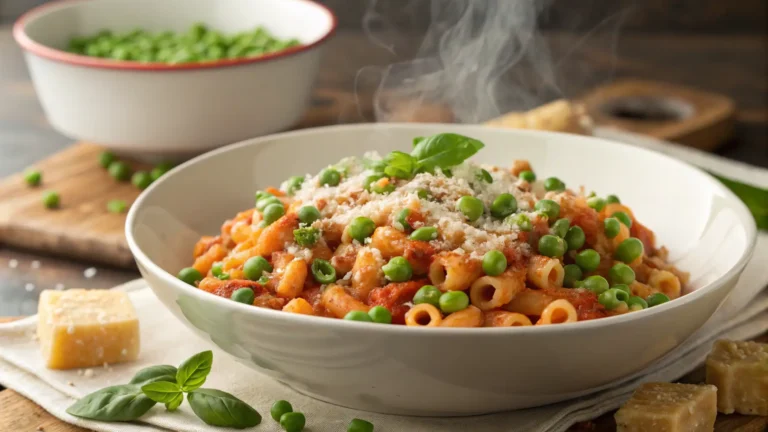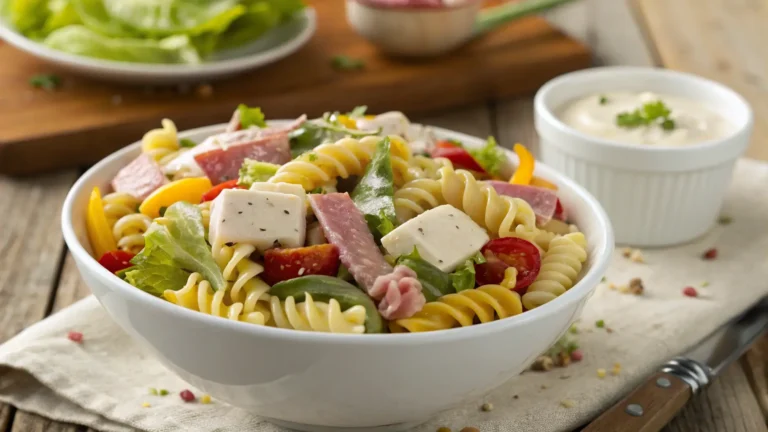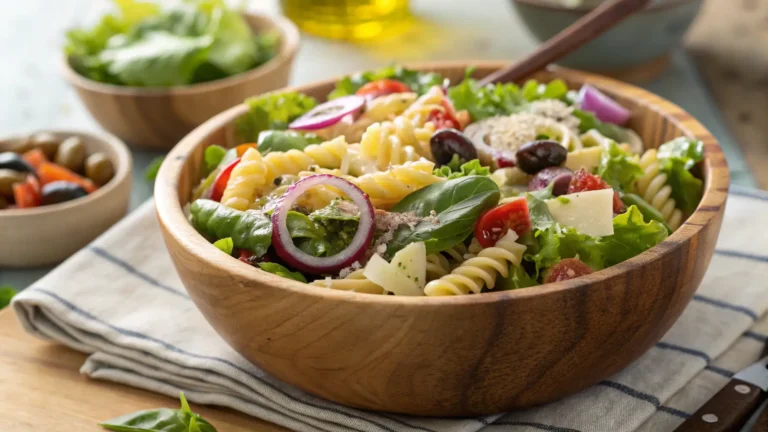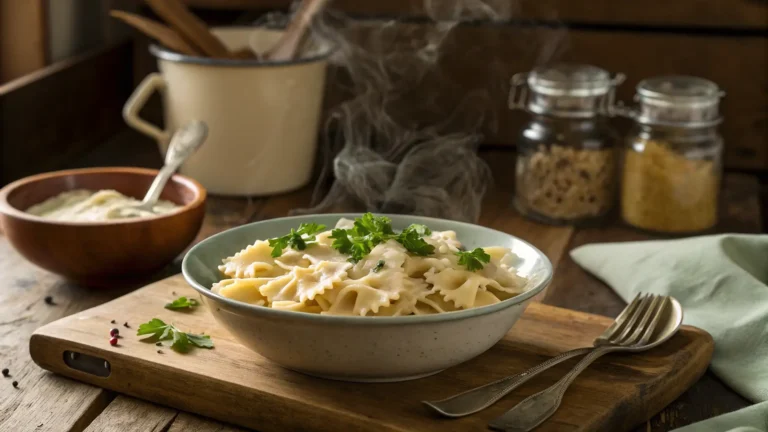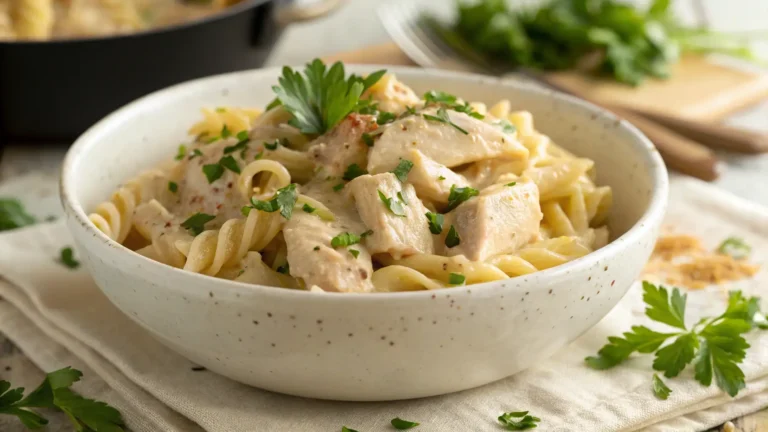Ditalini Pasta Recipe – The Best 9 Delicious Ways to Use It
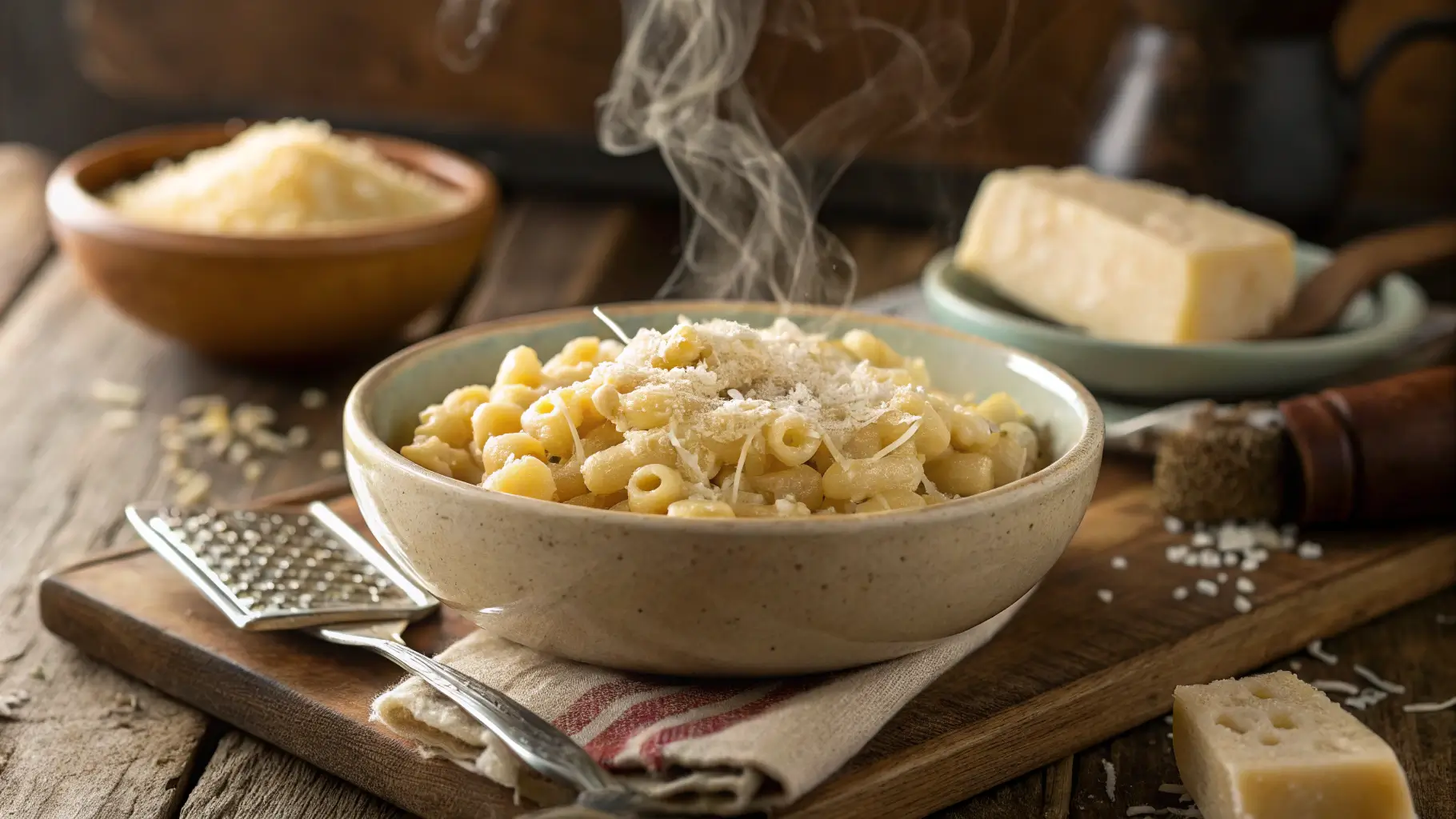
Table of Contents
If you’ve ever wondered how to make the most of a ditalini pasta recipe, you’re in for a treat. This small tube-shaped pasta has earned a place in kitchens around the world for its flavor-absorbing power and comforting texture. Whether you’re preparing a cozy soup, a hearty casserole, or even a twist on traditional mac and cheese, this guide to ditalini pasta will show you how to do it all.
In this article, we’ll cover how to cook ditalini pasta the right way, what makes it different from other shapes, and how to bring out the best flavors in every dish. From its Italian roots to modern American adaptations, this ditalini pasta recipe guide gives you all the tips, techniques, and meal ideas you need.
Check out our Ultimate Wagyu Ground Beef Recipe Guide for more hearty meal inspiration.
What is Ditalini Pasta?
– Origin and culinary history of ditalini
The heart of every good ditalini pasta recipe begins with understanding what makes this pasta so special. Ditalini, or “little thimbles” in Italian, originated in Southern Italy and is prized for its compact size and rich cultural roots. This pasta was a staple in rustic Italian households, especially in comforting dishes like pasta e fagioli—one of the most traditional ditalini pasta recipes ever made. s
Originally used to stretch soups in rural kitchens, ditalini has evolved into a favorite in homes and restaurants across the U.S. It’s not only practical but also satisfying, thanks to how well it absorbs sauces and broths.
– Why it’s called “ditalini” and what it looks like
The name “ditalini” comes from dito, the Italian word for “finger,” and the diminutive “-lini” makes it “little fingers.” The shape reflects its name—short, hollow tubes usually cut to a uniform size, perfect for soaking up bold flavors in any ditalini pasta recipe.
Ditalini pasta can come smooth or ridged and is often about a quarter-inch in length. Its open-ended shape allows it to trap broth or creamy sauces, making every spoonful burst with flavor. This design makes it ideal for quick and satisfying meals.
– Common uses in Italian and American kitchens
There’s no shortage of ways to use ditalini in your cooking. Traditionally found in Italian soups, it’s now a go-to ingredient in dishes like:
- Creamy ditalini pasta recipes with cheese
- Pasta salads tossed with olive oil and herbs
- Chicken and vegetable stews
- Classic pasta e fagioli
- Baked casseroles with breadcrumbs on top
Its small shape makes it quick to cook and perfect for families, especially when you need a fast dinner that still delivers on taste. When planning your next weeknight meal, a simple ditalini pasta recipe could be your answer.
Ingredients You’ll Need for the Perfect Ditalini Pasta Recipe
– Fresh vs dried ditalini pasta: flavor and texture differences
When preparing a ditalini pasta recipe, your first decision is whether to use fresh or dried pasta. While dried ditalini is more common and accessible in grocery stores, some home cooks prefer making it fresh from scratch.
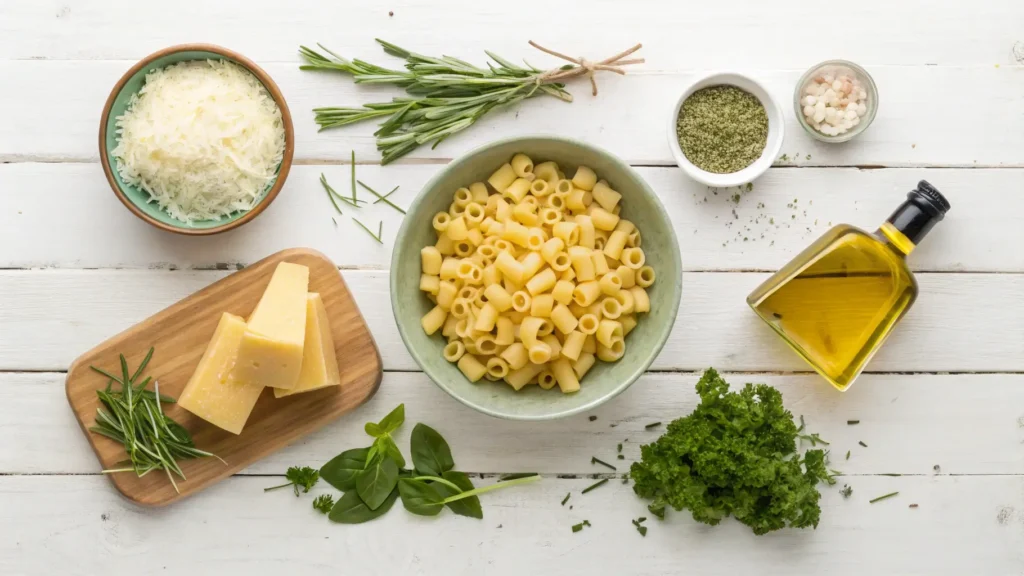
Dried ditalini holds its shape better during boiling, making it ideal for soups and stews. It’s shelf-stable, affordable, and offers consistent results. On the other hand, fresh ditalini pasta, often made with egg, has a slightly softer texture and cooks in half the time. However, it’s more delicate and might not stand up well in liquid-heavy dishes.
For most home cooks aiming for a traditional ditalini pasta recipe, dried pasta is the reliable choice. It’s also better for batch cooking and storing.
| Type | Cooking Time | Best For | Texture |
|---|---|---|---|
| Dried | 8–10 min | Soups, casseroles | Firm |
| Fresh | 3–4 min | Quick creamy dishes | Tender |
– Must-have ingredients for a classic dish
The beauty of a ditalini pasta recipe is that it doesn’t require fancy ingredients. You can keep it simple or elevate it with premium additions. Here’s what you need for a classic stovetop ditalini pasta base:
- Ditalini pasta (dried, 1 cup for 2 servings)
- Olive oil (extra virgin preferred)
- Garlic and onions (finely chopped)
- Tomato paste or sauce (for red base)
- Grated Parmesan or Romano cheese
- Salt and pepper
- Broth or water (for boiling)
These ingredients create the perfect foundation for variations like pasta e fagioli, creamy mac and cheese, or even a cold pasta salad.
If you’re making a soup-style ditalini pasta recipe, don’t forget:
- Vegetable or chicken broth
- Cannellini beans or chickpeas
- Chopped greens like spinach or kale
These additions add depth and nutrition while keeping the recipe light and hearty.
– Optional add-ins and variations
Want to add your personal twist? That’s where this pasta really shines. Ditalini’s neutral taste lets you experiment with endless variations:
- Protein options: Ground beef, pancetta, sausage, shredded chicken
- Veggies: Zucchini, peas, sun-dried tomatoes, mushrooms
- Spices: Red pepper flakes, oregano, fresh basil, Italian seasoning
- Cheeses: Mozzarella, ricotta, gouda for creamy sauces
- Sauces: Pesto, garlic butter, creamy béchamel, tomato-basil
You can easily create a ditalini pasta recipe that fits dietary needs or family favorites by mixing and matching these extras.
If you’re planning to store leftovers or prep for later, make sure to cook the ditalini slightly under al dente to avoid mushiness upon reheating.
How to Cook Ditalini Pasta the Right Way
– Cooking times and water ratio for ideal texture
No matter which ditalini pasta recipe you choose, proper cooking technique is key to achieving that perfect bite. Unlike larger pasta shapes, ditalini cooks quickly—usually within 8 to 10 minutes when boiled in salted water. Because it’s small, it absorbs liquid fast and can overcook easily, turning mushy.
To cook ditalini pasta the right way:
- Use 4–6 quarts of water per pound of pasta
- Add 1 tablespoon of salt per 4 cups of water
- Stir frequently in the first 2 minutes to prevent sticking
- Begin tasting at the 7-minute mark for doneness
- Drain immediately and do not rinse unless making a pasta salad
If your ditalini pasta recipe calls for adding the pasta directly into soup or broth, reduce the initial cook time by 2–3 minutes to prevent over-softening as it continues to simmer in the liquid.
| Cooking Method | Cook Time | Notes |
|---|---|---|
| Boiling in water | 8–10 min | Add salt, don’t overboil |
| Simmered in soup | 5–6 min | Cook last to avoid mushiness |
| Baked casserole | 6 min | Pre-boil before baking |
– Salt, oil, and pasta tips for flavor retention
There’s a myth that adding oil to pasta water prevents sticking—but for small pasta like ditalini, it’s unnecessary and can even prevent sauces from clinging properly. Instead, focus on seasoning your water generously. This is your one chance to flavor the pasta from the inside out.
Also, don’t forget to save some pasta water before draining. A ladle of starchy cooking water can help emulsify sauces or bring together creamy textures in your ditalini pasta recipe.
Best tips for cooking success:
- Always use salted water, even for soups or broths
- Avoid rinsing pasta unless making a cold salad dish
- Toss pasta immediately in your sauce to help absorb flavor
- Undercook slightly if finishing pasta in the sauce or oven
– Mistakes to avoid when boiling ditalini
Even experienced cooks make missteps when handling delicate pastas. If you’re making a one-pot ditalini pasta recipe, especially in soups or saucy meals, avoid these common mistakes:
- Overcooking the pasta: It turns mushy fast
- Using too little water: Leads to sticking and uneven cooking
- Skipping the stir: Especially in early minutes, this causes clumps
- Letting it sit in water: Always drain immediately
For best results, al dente is the goal—tender with a slight chew. That perfect texture makes all the difference in a creamy ditalini pasta bake or a zesty pasta salad.
3 Delicious Ditalini Pasta Recipes You’ll Love
– Ditalini Pasta Salad with Italian Dressing
Looking for a crowd-pleasing side dish? This ditalini pasta recipe for Italian-style pasta salad is crisp, colorful, and perfect for BBQs or weekly meal prep.
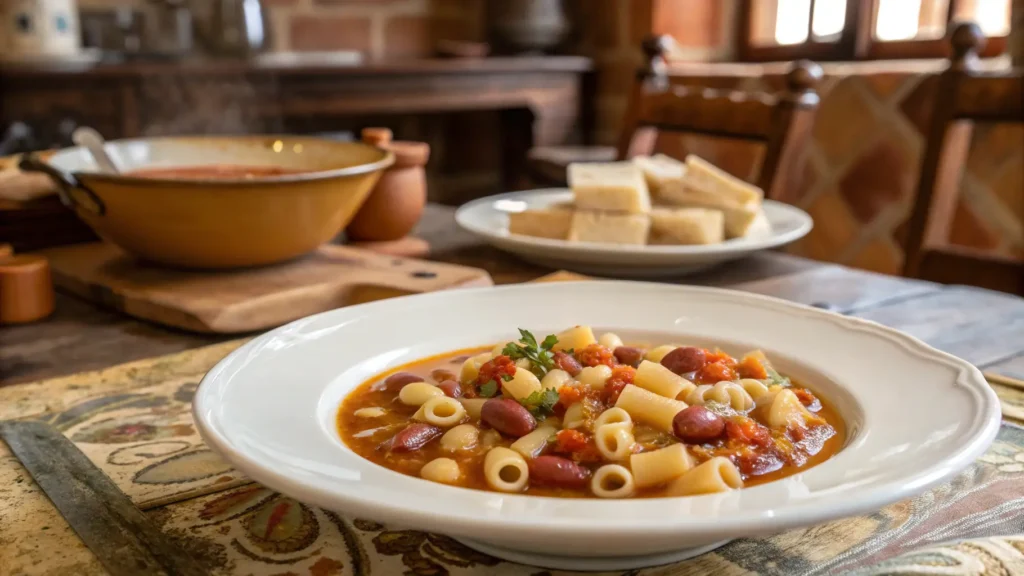
Ingredients:
- 2 cups cooked ditalini pasta
- ½ cup cherry tomatoes, halved
- ¼ cup black olives, sliced
- ½ cup chopped cucumber
- ¼ red onion, thinly sliced
- ⅓ cup Italian dressing
- Salt and pepper to taste
- Fresh parsley or basil for garnish
Instructions:
- Cook ditalini pasta al dente, then rinse under cold water to stop cooking.
- Combine veggies in a large bowl.
- Add pasta, toss with Italian dressing, and season.
- Chill for at least 30 minutes before serving.
This refreshing ditalini pasta salad holds up beautifully in the fridge and makes a fantastic light lunch or dinner side.
– Creamy Ditalini Mac and Cheese (Yes, it Works!)
Move over elbow macaroni—ditalini pasta recipes like this one bring a creamy twist to comfort food. Ditalini’s small shape captures cheesy goodness in every bite.
Ingredients:
- 1½ cups ditalini pasta
- 1½ cups shredded sharp cheddar
- 2 tbsp butter
- 2 tbsp flour
- 1½ cups milk
- ½ tsp garlic powder
- ¼ tsp mustard powder
- Salt and pepper to taste
Instructions:
- Cook pasta and set aside.
- In a saucepan, melt butter, whisk in flour to make a roux.
- Gradually whisk in milk, simmer until thick.
- Add cheese, stir until melted.
- Mix in ditalini pasta, season, and serve hot.
Want to spice it up? Try adding jalapeños, bacon bits, or swap cheddar for smoked gouda.
– Hearty Ditalini with Beans (Pasta e Fagioli Style)
One of the most traditional and satisfying ditalini pasta recipes is pasta e fagioli. This one-pot dish is filling, flavorful, and easy on the budget.
Ingredients:
- 1 cup ditalini pasta
- 1 tbsp olive oil
- 1 small onion, chopped
- 2 garlic cloves, minced
- 1 can cannellini beans, rinsed
- 1 can crushed tomatoes
- 2 cups vegetable broth
- 1 tsp dried oregano
- Salt, pepper, and parsley
Instructions:
- Sauté onion and garlic in olive oil until translucent.
- Add beans, tomatoes, broth, and spices. Simmer for 10 minutes.
- Stir in ditalini pasta, cook until al dente.
- Serve topped with Parmesan and fresh herbs.
This comforting bowl delivers a protein boost and fits vegetarian diets perfectly.
Each ditalini pasta recipe in this section proves that with just a few pantry staples, you can whip up dishes that are tasty, affordable, and family-approved.
What Can I Do With Ditalini Pasta?
– Soup bases, stews, and comfort dishes
One of the most popular ways to enjoy a ditalini pasta recipe is by adding it to hearty soups and stews. This pasta shape is made for comfort food. Because ditalini holds its structure in hot liquids, it’s the go-to choice for brothy dishes.
Top soup-style uses include:
- Pasta e fagioli (pasta and beans)
- Chicken and ditalini vegetable soup
- Tomato-basil broth with ditalini and spinach
- Italian wedding soup with ditalini instead of orzo
Its petite size ensures every spoonful is perfectly balanced with broth, beans, meat, or vegetables—no need to twirl or cut.
– Cold pasta dishes for summer
Warm weather calls for pasta salads, and ditalini shines in these no-fuss meals. Its small shape mixes well with diced veggies, dressings, and proteins, making it ideal for meal prep.
In fact, the ditalini pasta recipe featured earlier in our article—Italian Pasta Salad—is just one example. You can also build custom bowls with:
- Tuna or shredded chicken
- Roasted red peppers and capers
- Chopped artichokes and olives
- Chickpeas or kidney beans
- Zesty lemon vinaigrettes or balsamic glaze
With endless combinations, you’ll never run out of ideas for fast and flavorful cold meals.
– Family meal ideas with ditalini pasta
Parents love ditalini because it’s kid-friendly—no messy slurping or tough chewing. That’s why it’s often used in casseroles, creamy mac and cheese, and baked pasta dishes.
Busy families also appreciate how quickly ditalini cooks. In just 8–10 minutes, it’s ready to be mixed with sauces or stirred into leftovers. You can even sneak extra veggies in without complaints.
Want to expand your dinner options?
Discover great ideas like our Best Smoked Fish Brine Recipe for preserving deep flavor in any meal.
Looking to batch cook or prep freezer meals? Ditalini pasta works perfectly in:
- One-pot freezer soups
- Bake-and-store casseroles
- Layered pasta bakes with cheese and spinach
- Veggie-packed meatless Mondays
It’s this flexibility that makes any ditalini pasta recipe a must-have in your meal rotation.
Ditalini Pasta vs. Other Short Pastas
– What is the difference between Ditalini and Ditali?
At first glance, ditalini and ditali may look nearly identical—but subtle differences make each pasta unique. Both are small, tubular shapes used in similar dishes. However, ditali is slightly larger and thicker, while ditalini is shorter and narrower.
| Feature | Ditalini | Ditali |
|---|---|---|
| Length | Very short (¼ inch) | Slightly longer |
| Thickness | Thin-walled | Thicker tube |
| Common Uses | Soups, salads, creamy dishes | Chunkier sauces, baked pasta |
| Cook Time | 8–10 minutes | 10–12 minutes |
When making a delicate ditalini pasta recipe, like pasta e fagioli or mac and cheese, ditalini is often the better choice because it blends seamlessly with other ingredients and cooks evenly.
– Which pasta is closest to ditalini?
If you don’t have ditalini on hand, don’t worry—several short pasta shapes can serve as close substitutes. These alternatives have similar textures, cooking times, and functionality:
- Tubetti – Almost identical in size and perfect for soups.
- Elbow macaroni – Slightly curved, but works well in creamy dishes.
- Small shells (conchigliette) – Good in salads and brothy recipes.
- Orzo – Not tubular, but small and easy to substitute in soups.
- Anellini – Ring-shaped pasta that offers a fun twist, especially for kids.
Each of these options will yield similar results in most ditalini pasta recipes, though their textures may slightly alter the mouthfeel of the final dish.
– What pasta is like spaghetti but with a hole in the middle?
That would be bucatini—a long, thick pasta strand similar to spaghetti but with a tiny hole running through the center. Unlike ditalini, which is a short tube, bucatini is lengthy and designed to absorb more sauce from the inside out.
While bucatini and ditalini differ in shape and purpose, both fall into the category of hollow pasta types, which are excellent at capturing sauces. Bucatini is more suited for robust, tomato-based sauces and rarely used in the kinds of ditalini pasta recipes we’ve been discussing.
Is Ditalini Gluten-Free?
– Regular vs gluten-free ditalini pasta
The traditional ditalini pasta recipe uses semolina flour, which comes from durum wheat—meaning standard ditalini pasta is not gluten-free. This wheat-based flour gives pasta its firm texture and chew, making it a staple in Italian cooking but a no-go for those with gluten sensitivities or celiac disease.
However, the good news is that gluten-free ditalini options are widely available. These are typically made from:
- Brown rice flour
- Corn flour
- Quinoa flour
- Chickpea flour
- Lentil flour
Most of these alternatives cook just like traditional ditalini but may vary slightly in texture. For best results, follow the package instructions closely, as gluten-free pastas tend to cook faster and are more prone to over-softening.
Popular gluten-free brands offering ditalini or close equivalents include:
| Brand | Main Ingredient | Gluten-Free? | Texture |
|---|---|---|---|
| Barilla GF | Corn & rice blend | Yes | Firm, smooth |
| Jovial Foods | Brown rice | Yes | Slightly chewy |
| Banza | Chickpeas | Yes | Nutty, firm |
| Tinkyáda | Rice | Yes | Delicate |
If you’re planning a gluten-free ditalini pasta recipe, pair it with lighter sauces or broths to complement the slightly different texture.
– Which pasta types are lowest in gluten?
While traditional wheat-based pasta isn’t gluten-free, some low-gluten options may be easier to digest for those with gluten sensitivity (not celiac disease). These include:
- Kamut pasta – an ancient grain with lower gluten levels
- Spelt pasta – easier to digest than modern wheat
- Einkorn pasta – the oldest cultivated wheat variety, often more tolerable
But remember: “low gluten” is not the same as gluten-free. For anyone with celiac disease or strict dietary needs, always stick with certified gluten-free pasta alternatives when making your ditalini pasta recipe.
If you’re looking for a wheat-free alternative that mimics ditalini’s bite and versatility, try quinoa elbows or chickpea shells—they’re often stocked in gluten-free aisles and pair well with hearty sauces or cold salads.
Can You Use Ditalini for Mac and Cheese?
– Texture and bite: how ditalini compares to elbows
When it comes to mac and cheese, elbow macaroni tends to dominate. But here’s the secret: ditalini pasta is just as good—and in many cases, even better.
Thanks to its small, tube-like shape, ditalini holds onto creamy cheese sauces beautifully. Unlike elbows, which are curved, ditalini offers a uniform texture and cooks faster. This makes it a fantastic swap for any stovetop or baked mac and cheese ditalini pasta recipe.
Why it works well:
- Compact size absorbs sauce evenly
- Quick cook time = less overboiling risk
- Smooth or ridged surfaces cling to cheese perfectly
- Offers a more refined mouthfeel than larger shapes
If you’re making a family-friendly mac and cheese or prepping baked pasta in advance, ditalini is absolutely a winner.
– What kind of pasta does Panera use for mac & cheese?
Panera Bread is famous for its ultra-creamy white cheddar mac and cheese. The pasta shape they use is pipette rigate, which looks like a cross between an elbow and a shell. It’s short, curved, and ribbed to hold their signature sauce.
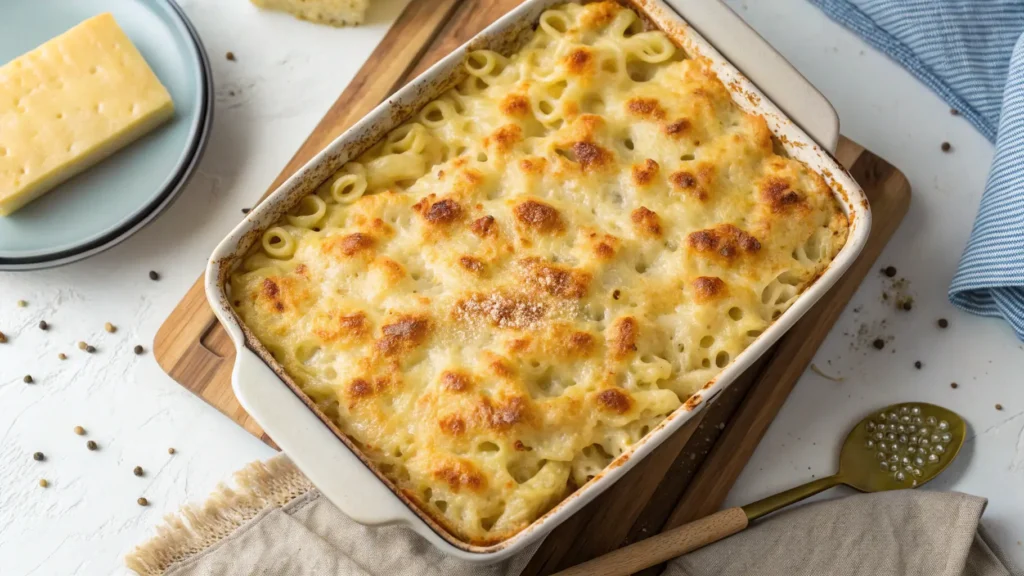
However, when crafting a homemade version, ditalini pasta offers similar sauce-hugging power in a bite-sized form—ideal for recreating restaurant-style textures without needing specialty pasta.
– Why use ditalini pasta instead of others?
If you’re still unsure whether ditalini is the right choice, consider this: many traditional pasta shapes are too large, soft, or unevenly sized for dishes like mac and cheese. Ditalini pasta, on the other hand, offers a small but mighty structure.
Here’s what makes ditalini a standout:
- Even cooking: All pieces cook uniformly
- No excessive chew: Kid-friendly and easy to eat
- Better sauce control: No oversaturation or slippage
- Perfect portions: Ideal for baked servings or small plates
You’ll find that a creamy ditalini pasta recipe for mac and cheese delivers just as much comfort and flavor as any traditional elbow-based version—sometimes more.
– What’s the best pasta to make mac and cheese?
While elbows are the default, pasta experts and chefs agree that short, ridged shapes like ditalini, cavatappi, shells, or penne work best because they trap and coat with sauce better than long noodles.
So, is ditalini one of the best options? Absolutely. It strikes the perfect balance between size, texture, and sauce-holding power—especially in baked recipes or stovetop versions for kids.
Creative Serving Suggestions and Storage Tips
– Pairing ditalini with meats, sauces, and veggies
One of the best things about a good ditalini pasta recipe is its adaptability. Whether you’re feeding picky kids or sophisticated guests, ditalini works across cuisines and occasions.
Here are some delicious ways to serve it:
- With meats: Pair ditalini with grilled chicken, Italian sausage, or slow-cooked beef for hearty meals. Its texture complements proteins without overpowering them.
- With vegetables: Stir in roasted zucchini, cherry tomatoes, spinach, or peas for colorful, veggie-packed bowls.
- With sauces: From creamy cheese to tangy marinara or zesty pesto, ditalini absorbs every drop. Even simple garlic butter or lemon olive oil works beautifully.
Try it in a baked casserole topped with breadcrumbs and mozzarella, or go Mediterranean-style with feta, olives, and artichokes for a cold pasta bowl.
No matter your preference, ditalini allows you to customize endlessly—making every ditalini pasta recipe feel new.
– How to store cooked ditalini for freshness
Ditalini stores quite well if handled correctly. Here’s how to keep it tasting fresh:
Refrigerator:
- Store in an airtight container for 3 to 5 days
- Lightly coat with olive oil to prevent sticking
- Add a splash of water before reheating in the microwave
Freezer:
- Best for baked ditalini dishes or sauced pasta
- Freeze portions in airtight containers for up to 2 months
- Reheat in oven-safe dishes or gently defrost overnight
Avoid freezing plain, unsauced ditalini—it tends to become mushy upon thawing.
– Batch prep ideas and lunchbox meals
Busy week? No problem. You can easily double your ditalini pasta recipe and use it for:
- Make-ahead lunches
- Kid-friendly thermos meals
- Soup bases stored in freezer bags
- Mason jar pasta salads for grab-and-go days
- Pasta muffins: mix ditalini with cheese and eggs, bake in muffin tins
With its quick cooking time and flexibility, ditalini helps you stretch ingredients and simplify your meal planning.
Conclusion: Why Every Kitchen Needs a Ditalini Pasta Recipe
If you’re looking for a pasta that’s quick to cook, fun to eat, and easy to flavor, a reliable ditalini pasta recipe is your answer. From cozy soups to creamy baked dishes and vibrant pasta salads, this small tube pasta shape proves that big flavors can come from little things.
Throughout this complete guide, we’ve explored how to cook ditalini to perfection, choose the right ingredients, and create go-to meals like pasta e fagioli and mac and cheese. We even compared it to similar shapes like ditali and tubetti—making sure you know exactly when and why to choose ditalini.
Whether you’re planning a gluten-free meal, prepping lunches for the week, or crafting a comfort classic for family dinner, having a solid ditalini pasta recipe in your rotation makes cooking easier and more flavorful.
With its versatility, speed, and simplicity, this pasta fits every occasion—and now, so does your ability to master it.
Looking for more flavorful combinations? Try our Ultimate Wagyu Ground Beef Recipe Guide to pair with your favorite ditalini pasta dish.
FAQs About Ditalini Pasta
What can I do with ditalini pasta?
Ditalini is perfect for soups, pasta salads, baked dishes, and creamy mac and cheese. Its small, tubular shape makes it ideal for dishes where you want even distribution of flavor in every bite.
What is the difference between Ditalini and Ditali pasta?
Ditalini is shorter and narrower than ditali. Ditali has a slightly larger diameter and is better for chunkier sauces, while ditalini blends more seamlessly in soups and casseroles.
Is ditalini pasta gluten free?
Traditional ditalini made from semolina flour contains gluten. However, gluten-free options are available using rice, corn, or chickpea flour from brands like Barilla GF, Banza, and Jovial.
Can you use ditalini pasta for mac and cheese?
Absolutely. Ditalini works great for mac and cheese because it captures creamy sauce in every bite. It cooks quickly and is easy for kids and adults alike.
What is the closest pasta to ditalini?
Tubetti is the closest match in shape and size. Other good substitutes include elbow macaroni, small shells, or anellini for soups and salads.
Which pasta is lowest in gluten?
Ancient grain pastas like einkorn, spelt, or kamut contain lower gluten levels than modern wheat. However, they still contain gluten and are not suitable for celiac diets.
What kind of pasta does Panera use for mac and cheese?
Panera uses pipette rigate—a short, curved tube pasta. For homemade versions, ditalini offers a similar texture and excellent sauce retention.
Why use ditalini pasta?
Its even shape, fast cooking time, and ability to hold sauces make it ideal for family meals, batch cooking, and versatile recipes across all seasons.
What’s the best pasta to make mac and cheese?
Short, ridged shapes like ditalini, elbows, shells, and cavatappi work best. Ditalini offers a refined bite with full flavor in every spoonful.
What pasta is like spaghetti but with a hole in the middle?
That pasta is called bucatini. It’s long like spaghetti but has a center hole, unlike ditalini which is short and used for very different dishes.
Have you given our recipe a try?
There are no reviews yet. Be the first one to write one.

